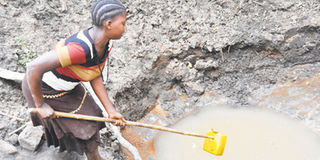Thirsty citizens: Plenty of water but none for drinking

According to a recent report by Twaweza, using data from 2016, slightly more than half (54 per cent) of the population in mainland Tanzania is estimated to have access to clean and safe water, PHOTO | FILE
What you need to know:
- As the world commemorated World Water Day, the WHO/UNICEF Joint Monitoring Program for Water Supply and Sanitation (JMP) 2015 report showed that little progress has been made towards improving access to clean and safe water especially in sub Saharan countries since 1990s. Despite decades of promises to improve access to clean and safe water, and billions of dollars spent, 663 million people still do not have access to clean drinking water and relied on unimproved water sources like unprotected wells, springs and surface water.
Water is life and access to water is vital for quality of life and social wellbeing. The UN’s Sustainable Development Goal (SDG) 6 calls for universal and equitable access to safe and affordable drinking water by 2030 of which the first step is providing everyone with a basic service within a 30-minute round trip, and the long term goal is to ensure everyone has safe water available at home.
As the world commemorated World Water Day, the WHO/UNICEF Joint Monitoring Program for Water Supply and Sanitation (JMP) 2015 report showed that little progress has been made towards improving access to clean and safe water especially in sub Saharan countries since 1990s. Despite decades of promises to improve access to clean and safe water, and billions of dollars spent, 663 million people still do not have access to clean drinking water and relied on unimproved water sources like unprotected wells, springs and surface water.
In Tanzania, the picture is no different. Despite the country having abundant surface and ground water resources from the numerous rivers, lakes, wetlands and aquifers, there are severe and widespread water shortages across the country. Though the country has made water a priority in their poverty reduction strategies since 2005 through various polices and increase in water financing, there is little to show for these efforts.
According to a recent report by Twaweza, using data from 2016, slightly more than half (54 per cent) of the population in mainland Tanzania is estimated to have access to clean and safe water, with stark differences between urban (74 per cent) and rural (46 per cent) areas. The report further shows that the trend in water access especially for rural areas has stagnated in the past decade with unimproved sources like unprotected wells (26 per cent) and surface water (20 per cent) being the main sources of water to the rural population. These sources provide poor quality water susceptible to contamination from high fluoride concentrations, turbidity level and bacteria. Using a narrower definition of access to clean and safe water, in 2016, 61 per cent of households in urban mainland Tanzania had access to piped water, as opposed to 28 per cent in rural areas.
Twaweza’s report further shows that for more than 40 per cent of the citizens (57 per cent rural and 28 per cent urban) collecting water from a clean and safe source takes more than 30 minutes per roundtrip. This burden is borne by either female members of the household (80 per cent) or by children (16 per cent). The time spent collecting water considerably shortens the time women spend with their families, on child care, other household tasks, or even in leisure activities. For children, water collection takes away time from their learning both at home and school, as well as time for play.
While availability of piped water at home may seem trivial to human survival, water collected from another source, even if safe, is in the transportation and storage subjected to contamination.
This in turn increases the risk of diarrheal diseases, which is the fourth leading cause of death among children under 5, and a leading cause of chronic malnutrition, or stunting, which affects 159 million children worldwide. According to UNICEF, globally more than 300,000 children under 5 die each year from diarrheal diseases due to poor sanitation, poor hygiene, or unsafe drinking.
To quote UNICEF’s global head of water, sanitation and hygiene, Sanjay Wijesekera: “No matter where you look, access to clean and safe drinking water makes a difference in the lives of people.”
Melania Omengo is the Manager of Sauti za Wananchi at Twaweza East Africa




